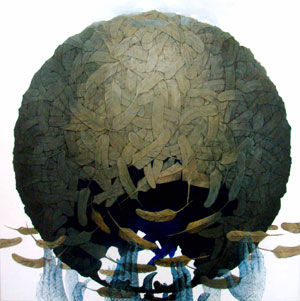Qamar Siddiqui’s Art Show at Chawkandi Gallery
By Zehra Nabi | Art | Arts & Culture | Published 13 years ago
The word ‘grotesque’ is commonly understood to mean ugly or monstrous. But when the word is used in the context of art, the meaning becomes somewhat harder to define. Art historians have normally associated ‘grotesque’ with a style of art that is ornate and incorporates fantastical imagery. Grotesque also means an aesthetic that goes against conventions and in which various objects are incorporated into the human form.
It is this latter set of definitions of the word that resonates in Qamar Siddiqui’s latest show, Reality of Life, which was exhibited at the Chawkandi Art Gallery this October. In many of his paintings, human figures are covered in layers of what appear to be white feathers or bandages. In the ‘In Between’ series, these mummified figures are hunched over on the ground and as the series progresses, the bodies become less human-like and increasingly abstract.
In his artist statement, Siddiqui states that his use of colours is highly symbolic, with white representing purity and red signifying the material world. In that context, the white, cocooned figures suggest almost a foetal quality and in the few paintings where the stylised faces are visible, their expressions appear serene. In this particular series, the colour red makes its way into the canvas in the form of red high heels in one painting and a checkerboard pattern slowly making its way up the body in others.
The talk of the show was ‘Reality of Life,’ a grand tryptich, which dominated the gallery. On one panel of the painting, Siddiqui has painted a crouching winged figure with enlarged feet and hands and covered with the same feather-like objects seen on other canvases. On another panel, there is a similarly positioned figure, except this time it is covered in red and black checkerboard print. The central panel, which is also the largest, has multiple white figures crowded round an amorphous red mass — a confrontation of sorts between the two ideologies.
 Looking at the collection at large, the delicate layers of feathers seem to serve as a veneer against the imposing red presence of materialism. In Siddiqui’s paintings, the human figure itself is rendered white, suggesting the idealised notion that mankind is, by nature, innocent. There were some exceptions to this red/white colour scheme as yellows and blues were employed in a handful of the works. In ‘Reality of Development’ — a striking painting that was perhaps overshadowed by other bolder pieces in the collection — Siddiqui paints a spherical structure made of hundreds of feathers and the recess inside is a dark, inky blue. Pale blue, translucent hands beckon towards the sphere from the edge of the canvas and the painting exudes a tranquil, even ethereal quality.
Looking at the collection at large, the delicate layers of feathers seem to serve as a veneer against the imposing red presence of materialism. In Siddiqui’s paintings, the human figure itself is rendered white, suggesting the idealised notion that mankind is, by nature, innocent. There were some exceptions to this red/white colour scheme as yellows and blues were employed in a handful of the works. In ‘Reality of Development’ — a striking painting that was perhaps overshadowed by other bolder pieces in the collection — Siddiqui paints a spherical structure made of hundreds of feathers and the recess inside is a dark, inky blue. Pale blue, translucent hands beckon towards the sphere from the edge of the canvas and the painting exudes a tranquil, even ethereal quality.
Even though the various figures may appear grotesque, and the themes deal with a clash of values, there is an underlying sense of beauty and calm in Siddiqui’s latest collection.
This article was originally published in the November issue.
Zehra Nabi is a graduate student in The Writing Seminars at the Johns Hopkins University. She previously worked at Newsline and The Express Tribune.


